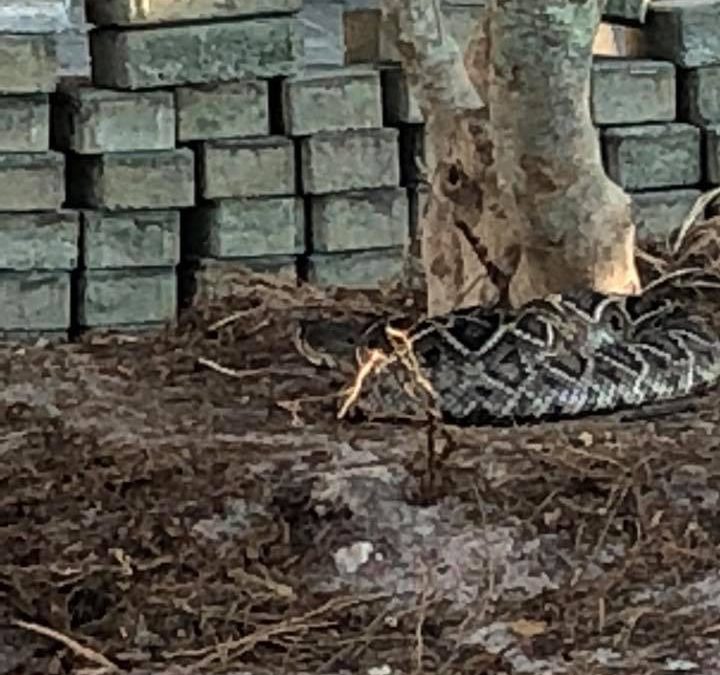
by Rick O'Connor | Dec 7, 2018
This seems like a strange title… of course they are still around. However, it is referring to the number of encounters beach residents in the Pensacola Beach have had this year. The first report was of a large individual coiled beneath a palm tree near a condominium unit by the gate of Ft. Pickens. Park officials relocated that snake. Soon after, another individual was found swimming in the surf of the Gulf of Mexico within the national seashore (honest… that is a strange place to find a rattlesnake). A third was photographed snake crawling near the gate at Johnson’s Beach on Perdido Key, again within the national seashore. I found a small individual coiled in the hollow space of a live oak tree at Naval Live Oaks in Gulf Breeze, again – within the seashore. And last week I was driving through the Ft. Pickens area and saw another crossing the road near Battery Worth; it safely made it across the road.
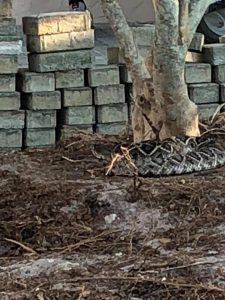
Diamondback rattlesnake near condominium construction site Pensacola Beach.
Photo: Sawyer Asmar
Some would say, “Safely made it across the road? I would not worry about safely making it across the road” – but most of you know I am a fan of snakes and do not wish them ill will. Others feel similar but would rather they stay away from people. I get that. Some would have tried to run over the snake so that it was not a threat to others in the park. I understand that thought process also but, as had been said before by many, snakes are beneficial to the ecosystem – benefitting us by controlling disease-carrying rodents, and rarely approaching people – it is usually the other way around. Besides, this is a national park – you cannot run over snakes there.
So what’s up with all the recent encounters?
Is the island overrun with snakes?
This question came up last spring over on Perdido Key when a community was frequently encountering cottonmouths. It would obviously take a population assessment by a qualified herpetologist to determine the density of snakes per acre; but no such study is being conducted – nor are there plans for one anytime soon. They tend to avoid people and, typically, become more visible when they are pushed from their hiding places. They are also more visible during breeding season, which for the eastern diamondback rattlesnake is late summer and fall.
There is concern for safety when discussing the rattlesnake. So let’s learn a little more about this animal. To know them better is to learn how to avoid problems with them.
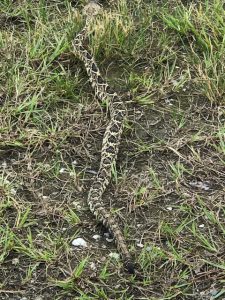
Eastern diamondback rattlesnake crawling near Ft. Pickens Campground.
Photo: Shelley Johnson
The Eastern Diamondback Rattlesnake (Crotalus adamanteus) is the largest venomous snake in North America, reaching lengths of eight feet and 4-6 lbs. (though some have weighed as much as 15 lbs.). They prefer high dry ground, such as the dune fields of barrier islands, feed on a variety of rodents, and have a particular fondness for rabbits. Word is, if there are rabbits – there may be rattlesnakes.
When small, they have numerous predators including raptors, mammals, and even bullfrogs. To defend themselves, they lie beneath vegetation cover during the summer months and within burrows and stump holes in the winter. Unlike the cottonmouth, rattlesnakes prefer to hunt during the daylight hours.
They breed in the fall just before the first cold temperatures and then settle into a burrow for the winter. They will have 12-24 young, delivered live, and the females will stay with the young until they shed their first skin, at which time the young are on their own.
They tend to avoid human contact and rarely venture into our territory unless (a) we have provided good habitat for their prey, (b) we have reduced their preferred habitat to a point they have no choice. Locally, all recent encounters (less one) have been within the National Seashore. One encounter was in the dune fields near Big Sabine. These are all natural habitats far from people – which is a good thing.
Rattlesnake venom is potent, and people should keep a respectful distance for this animal. My college professor said their venom is “expensive” and meant for killing prey. What he meant by “expensive” was in terms of the energy and compounds to produce it. That said, they would inject venom if their life depended on it. One encounter I read about on a barrier island in Georgia involved a large eastern diamondback. He said the head was close to 4 inches and the coiled body was large enough to cover a manhole. He was not sure how long the snake was, but needless to say – it was a large snake. He was actually a herpetologist who works with snakes and was searching for them. He had a steel snake tong with him. He used that to cover his leg and walked past the snake. The snake never made an attempt to strike convinced it was camouflaged and did not need to. He looked back after walking a few feet and the rattlesnake remained in the coiled position awaiting a rabbit. Snakes that are annoyed will often rattle and lift into the S-shape strike position. You should give an animal doing this plenty of room, their strike range is 2/3 their body length.
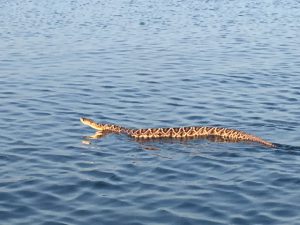
Eastern diamondback rattlesnake swimming in intracoastal waterway near Ft. McRee in Pensacola.
Photo: Sue Saffron
Despite our fears, these are fascinating and beneficial animals. There is a variety of reasons we may be seeing more on our barrier islands, but understanding them will help reduce negative encounters.
References
Gibbons, W. M. Dorcas. 2005. Snakes of the Southeast. University of Georgia Press. Athens GA. pp. 253.
Graham, S. 2018. American Snakes. John Hopkins University Press. Baltimore MD. pp. 293.
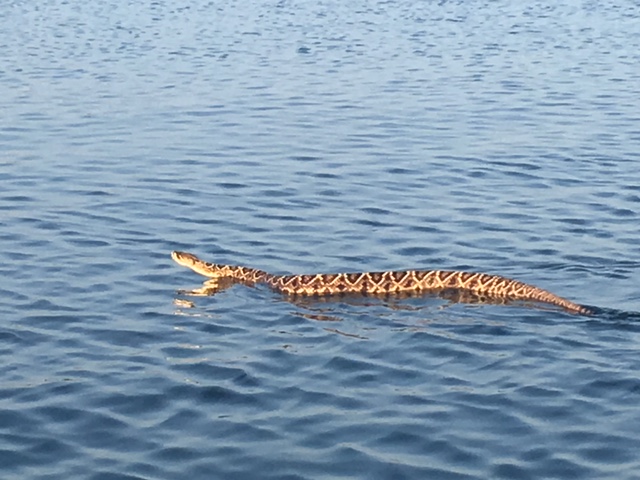
by Rick O'Connor | Sep 28, 2018
In the past week, three eastern diamondback rattlesnakes were encountered near the Ft. Pickens area on Pensacola Beach. The first was at a condominium unit near the park gate where construction work was occurring, the second was found swimming in the surf of the Gulf of Mexico within the national seashore, and the third was in the national seashore’s campground. This is an animal we rarely encounter on our barrier islands – but that is the keyword… encounter… they are there, but tend to avoid us.

Eastern diamondback rattlesnake crawling near Ft. Pickens Campground.
Photo: Shelley Johnson
Report on rattlesnake in Gulf surf –
https://www.pnj.com/story/news/local/2018/09/26/snake-rescue-pensacola-beach-shocks-visitors/1430731002/
The eastern diamondback rattlesnakes (Crotalus adamanteus) is the largest venomous snake in the United States. An average snake will reach six feet and five pounds, but they can reach eight feet and up to 15 pounds. Because of their large bodies, they tend to move slow and do not often try to escape when approached by humans. Rather, they lie still and quite hoping to be missed. If they do feel you have come to close, they will give their signature rattle as a warning – though this does not always happen. If they are considering the idea of striking – they will raise their head in the classic “S” formation. Know that their strike range is 2/3 their body length – larger than many other native snakes – so a four foot snake could have a three foot strike range. Give these snakes plenty of clearance.
Eastern diamondback rattlesnakes prefer dry sandy habitats, though they are also found in pine flatwoods (such as Naval Live Oaks north of highway 98 in Gulf Breeze). They are quite common in the upland sandhills of longleaf pine forests. They spend the day in tree stump holes and gopher burrows and hunt small mammals and birds in the evenings. They are particular fond of rabbits. The dunes of our barrier islands are very similar to the sandhills of the pine forest further north. They are actually good swimmers and saltwater is not a barrier – distance is. They have been seen numerous times swimming from Gulf to Pensacola Beach or the opposite. Again, they tend to avoid encounters with humans and are not often found on lawns etc.
Diamondbacks give birth to live young around August. The females will find a dark-cool location to den and give birth several young. Anywhere from four to 32 offspring have been reported. The female remains with the young for about 10 days until they have their first molt (skin shedding) and then she leaves them to their fate.

Diamondback rattlesnake near condominium construction site Pensacola Beach.
Photo: Sawyer Asmar
So what’s up with three encounters in a relatively small location within one week?
My first inclination is two possibilities – maybe a combination of the two.
- We have had a lot of rain this year – and then T.S. Gordon came through. Snakes like to be on high dry ground as much as anyone else and they tend to move closer to human habitats because they are built on higher ground.
- Breeding season for eastern diamondbacks is late summer early fall. This time of year, the males are on the move seeking interested females – so they are encountered more.
As far as finding one in the surf of the Gulf of Mexico. I am not sure. I have never seen this and the newspaper account suggested it was not doing well when found. Again, I have seen plenty swimming the Intracoastal but this is a first for the Gulf. I would say it had wondered the wrong way.
They are actually fascinating animals and are not a threat unless you approach too close. Give them room and feel lucky if you get to see one.
References
Eastern Diamondback Rattlesnake. Natural History. Center for Biological Diversity. https://www.biologicaldiversity.org/species/reptiles/eastern_diamondback_rattlesnake/natural_history.html.
Krysko, Kenneth L., and F. Wayne King. 2014. Online Guide to the Snakes of Florida. Florida Museum of Natural History, University of Florida, Gainesville, FL, USA. [Online: September 2014] Available at: http://www.flmnh.ufl.edu/herpetology.
https://www.floridamuseum.ufl.edu/herpetology/fl-snakes/list/crotalus-adamanteus.
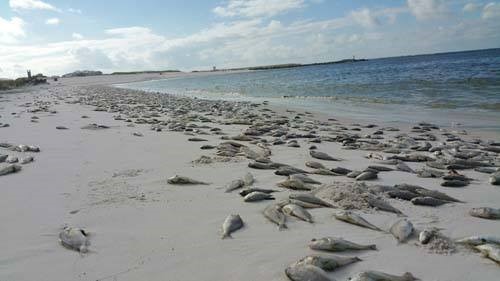
by Rick O'Connor | Sep 21, 2018
When I was in high school we were required to take a semester of communism during our senior year – the idea was to “know the enemy”. That is what we plan to do here… But, the enemy is a microscopic plant.
Its name is Karenia brevis. It is one of about 10 species of Karenia found in the ocean but it is the dominant form in the Gulf of Mexico. Karenia is referred to as “phytoplankton”, which suggests it is a microscopic plant. But in fact, it is in the Kingdom Protisita, not Plantae.
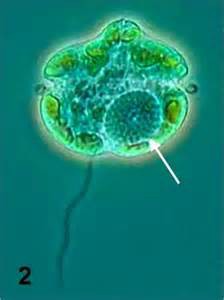
The dinoflagellate Karenia brevis.
Photo: Smithsonian Marine Station-Ft. Pierce FL
It is “plant-like” in that it has chlorophyll and can produce its own food. It differs in that it is a single cell. They are a type of phytoplankton called “dinoflagellates” because they have two flagella. The next question of course is what is flagella? It is a hair-like structure used by the cells for location. Though they can swim, they cannot out swim a current and so drift in the ocean – using their flagella to move up and down within the current and orient themselves.
The cell is covered with a protective shell called a theca, which as grooves, known as girdles, in which the flagella lie – one running east-west, the other north-south. They are between 18-45 microns long with the north-south flagella extending to look like a tail. They are members of the Gulf of Mexico community. Always out there, always have been. Typically, a plankton sample might find 1000 cells / liter. At these concentrations there does not seem to be a problem.
A problem?
What’s the problem?
The problem is that in its defense, K. brevis will release toxins. The toxin is a cocktail of lipophilic polyether compounds called brevotoxins. At low, or background concentrations, the levels of brevotoxins does not seem to effect marine organisms much at all. However, when the population of cells increases, to say 2 million / liter, fish kills can occur. The state of Florida will close shellfish harvesting if the concentrations reach 5000 / liter.
This brevotoxin is pretty strong stuff. It effects the nervous and immune systems, and effects the respiratory system. For marine vertebrates, it is deadly. At concentrations over 1,000,000 cells / liter, it can cause death for fish, dolphins, sea turtles, and manatees. Shellfish are filter feeders. During large blooms of K. brevis shellfish can consume enough to make humans very sick if they consume the shellfish.
So what causes their numbers to increase from 1000 to 1,000,000 cells / liter?
Summer…
Though K. brevis is not a plant, it is plant-like. Plants like sunlight and fertilizers. Warm shallow seas of southwest Florida are perfect. Nutrients are available in the environment and growth begins. Most blooms (large growth spurts) occur offshore. They love high salinities and not as common in our estuaries. However, they are plankton – wind and currents can move them closer to shore. During the raining season (summer) run-off from land brings with it nitrogen and phosphorus (nutrients) which can enhance a bloom. The fish kills begin, the respiratory problems for humans are annoying, and the tourist become concerned. Red tide can certainly have an impact on the local economy.
Globally, algal blooms seem to be increasing. Red tide can last a few days or a few months, each year varies. These are not exotic species; they are local Gulf residents who are finding warmer, saltier seas that they love. Algal blooms typically occur from September to February and though are common in southwest Florida, can extend across the Gulf to Texas – which the Florida panhandle is experiencing currently.
As Dr. Karl Havens mentions in his article attached, we cannot control the weather, but we can control the amount of nutrients we allow into our waterways. We should consider management practices that do just this to reduce the effects of these naturally occurring blooms.
Below are other articles from Sea Grant on this topic.
Frequently Asked Questions About the 2018 Red Tide Bloom – Betty Staugler, Florida Sea Grant
http://blogs.ifas.ufl.edu/charlotteco/2018/08/14/frequently-asked-questions-about-the-2018-red-tide-bloom/.
Understanding Florida’s Red Tide – Betty Staugler, Florida Sea Grant
https://www.flseagrant.org/news/2018/08/understanding-the-florida-red-tide/.
Watching and Waiting: Uncertainty About When the Algal Blooms Will End – Dr. Karl Haven, Florida Sea Grant
https://www.flseagrant.org/news/2018/07/watching-and-waiting-uncertainty-about-when-algae-blooms-will-end/.
REFERENCES
About Florida Red Tides. Florida Fish and Wildlife Conservation Commission. http://myfwc.com/research/redtide/general/about/.
Indian River Lagoon Species Inventory. Karenia brevis. Smithsonian Marine Station at Ft. Pierce. http://www.sms.si.edu/irlspec/Kareni_brevis.htm.
Pierce, R.H., M.S. Henry. 2008. Harmful Algal Toxins of the Florida Red Tide (Karenia brevis): natural chemical stressors in South Florida coastal ecosystems. Ecotoxicology. 17(7). Pp. 623-631. http://www.sms.si.edu/irlspec/Kareni_brevis.htm.
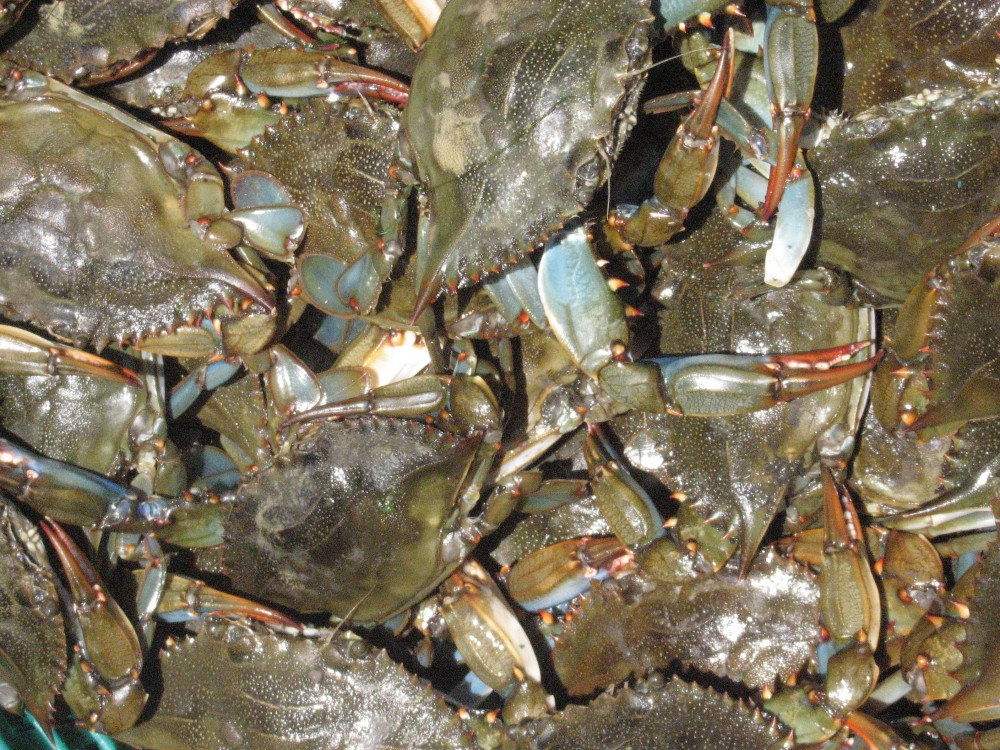
by Rick O'Connor | Sep 2, 2018
Most kids who grew up on the Gulf Coast grew up catching blue crabs. These animals are common along our shorelines, relatively easy to catch, and adventurous because they may bite you. I caught my first one in 1965 and we proudly displayed the boiled shell over the kitchen bar for many years. This is also a popular seafood target with an estimated commercial landing value of $56,950 in the Pensacola Bay area in 2017.
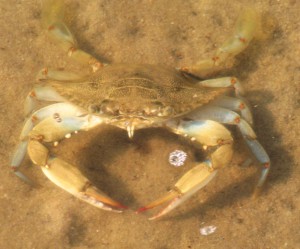
Blue crabs are one of the few crabs with swimming appendages.
Photo: Molly O’Connor
But who is this crab that we enjoy so much? What do we know about it?
As you probably already know, it is one of an estimated 30,000 species of arthropods we call crustaceans. Crustaceans differ from insects and arachnids in that they have five pairs of legs and two sets of antenna. Insects typically have a head, thorax, and abdomen – however, in the crustaceans the head and thorax are fused into what is called a cephlathorax and covered with a section of the shell called the carapace. Like all arthropods, their body are completely covered in a chitinous shell that serves as their exoskeleton. This exoskeleton must be periodically shed (molting) so they can continue to grow. Crustaceans tend to molt about 10-11 times each year and typically in the summer months. To molt, crustaceans will remove some of the salts and minerals from the shell into their tissue, this weakens the shell enough to separate it. The crack is usually between the cephlathorax and abdomen. When they emerge, they are completely soft and about 30% larger than before – it is amazing to see this large crab emerge from the small shell it once lived in. Because of the softness of the body after molting, this is usually done under the cover of darkness for protection. The salts and minerals it removed during pre-molting are now used to harden the new shell – which can take a couple of days. It is at this stage we call them “soft shells”.
The crustaceans include many different kinds of arthropods – most notably are the crabs, shrimps, and lobsters. There are over 4500 species of crabs and they differ from shrimps and lobsters in the fact their abdomen flexes beneath their body – you do not see the “tail” you see in a lobster or shrimp – but its there. Crabs can also move very well laterally, which their cousins are not so good. Blue crabs differ from other crabs in that their last pair of legs are modified as paddles and the animal can swim. They can swim forwards, backwards, and laterally – and they are often seen swimming at the surface. There are other crabs who have these swimming paddles and they are all called protunid crabs.
Blue crabs perceive their world through their eyes, antenna, and sensory cells on their body. They are very good at burying in the sand – eyes and antenna exposed – and sensory cells all working – seeking prey and avoiding predators. Their eyes differ from ours in that they have numerous lenses, compared to our single one, and are called compound eyes. Each lens does not provide them with an image of you or me however. Rather each lenses provides them with a single pixel of light. It is much like the image you see on television when they are trying to block out a brand name, or someone’s face. The more pixels (lenses) you have, the clearer the image. Those this type of eye does not give as clear an image as ours; it is very good at detecting motion and has served the arthropods very well over the years.
For blue crabs, food can be just about anything. They are active hunters – usually using the ambush method of capture (buried in the sand), but are also known scavengers – eating any bits of food they can find. Those enjoy crabbing know this – you can put just about anything as bait in a crab trap and it works. They have numerous predators including fish, birds, mammals, and sea turtles.
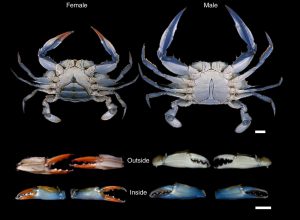
Male and female blue crabs.
Photo:
Blue crabs can be found in a variety of salinities (euryhaline). Males are typically found in the lower salinities of the upper bay. Females join them during mating season – which is in late spring and summer. Males cradle the females beneath his legs for several days waiting for the right location and moment to breed. Fishermen refer to them as “doublers” during this time. The females will molt and the male will then deposit his sperm into a sac called a spermatophore – which he then deposits to the female. She will then migrate to the more saline lower portions of the lower bay, while he remains and seeks another female. This may be the only spermatophore she receives her entire life – which can be up to five years, though most do not live beyond three years. She will use sperm from this spermatophore over that time to fertilize eggs.
The eggs develop in a sponge mass that develops beneath her abdomen. This egg mass is orange when in early development and becomes a darker brown with age as the larvae consume the yolk. There can be between 750,000 and 2,000,000 developing eggs within this mass. The females are called gravid at this stage and it is illegal to harvest gravid crabs in Florida.
The eggs hatch in about two weeks and a small microscopic mosquito looking larvae emerges – at this stage, they are called zoea. The zoea drift into the Gulf of Mexico where they feed and molt. Eventually they return to the estuary and become a microscopic crab with a tail – this stage is called a megalops. The megalops will feed and molt. The tail will eventually flex beneath and the crab becomes sexually mature. The entire process from hatching to sexual maturity is about 12-18 months.
These are fascinating animals. They are very common and a large part of the coastal culture of the Florida panhandle. Kids will have great fun catching them with a hand net, letting them swim in their beach buckets, but be sure to let them go before you head home and watch those claws – they do know how to use them. It is a great animal.
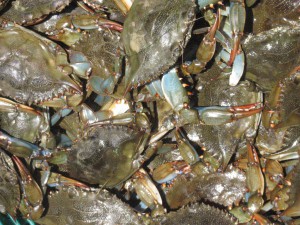
The famous blue crab.
Photo: FWC
Recreational Blue Crab Harvest Regulations in Florida
No size limit
10 gallons whole / harvester / day
Harvesting gravid females is prohibited
Five crab traps / person – cannot be placed in navigation channels
Trap closed season in Florida panhandle – Jan 5-14 in odd years.
References
Barnes, R.D. 1980. Invertebrate Zoology. Saunders College Press. Philadelphia PA. pp. 1089.
Blue Crab. Callinectes sapidus. Chesapeake Bay Program. 2018. https://www.chesapeakebay.net/discover/field-guide/entry/blue_crab.
Florida Fish and Wildlife Conservation Commission. Commercial Landings in Florida. 2017-2018. http://myfwc.com/research/saltwater/fishstats/commercial-fisheries/landings-in-florida/.
Florida Fish and Wildlife Conservation Commission. Recreational Blue Crabbing. http://myfwc.com/fishing/saltwater/recreational/blue-crab/.
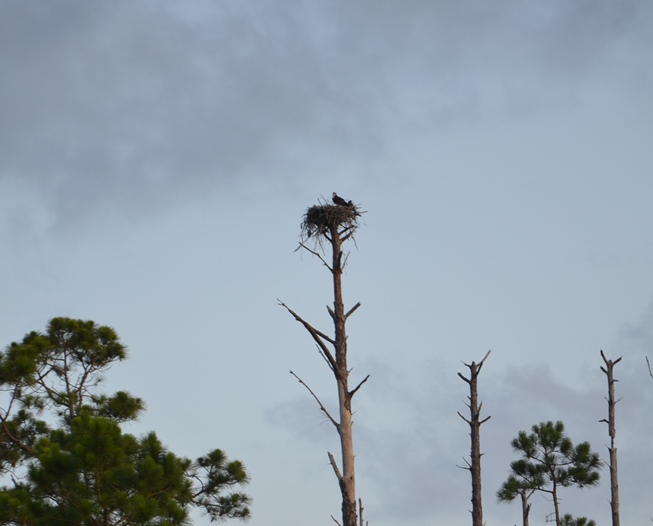
by Rick O'Connor | Aug 17, 2018
As a kid growing up here along the Gulf Coast, I had never heard of an osprey. Now, there is at least one mating pair on almost every body of water in the Pensacola Bay area. Where did this once unknown bird come from? How has it successfully colonized our coastal waterways?
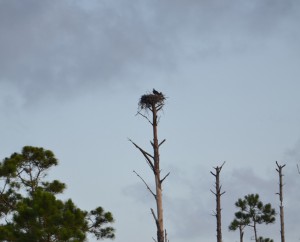
Osprey nesting sites are commonly near water, and their food source.
The osprey, like many other fish eating birds, was a victim of the DDT story. This miracle pesticide was developed to battle insects attacking food crops but was found to be useful against mosquitos and many other unwanted pests. It was sprayed everywhere using planes, trucks, and tractors. With an extremely long half-life, wherever it landed it was going to be around for a while – it can still be found in the sediments of the Pensacola Bay System. It was one of those compounds that was difficult to excrete through an organisms excretory system – thus it accumulated within their tissues, and as organisms fed on other organisms, it was passed up the food chain – bioaccumulation. Birds of prey who fed on fish would accumulate DDT as well. It caused the shells of their eggs to become thinner – so nesting was not successful – and many of the aquatic birds of prey (pelicans and eagles alike) declined in number. DDT was banned in 1970s and many of these fish eating birds have made a remarkable recovery – a true success story.
So who is this fish eating bird of prey that can be found on dead trees and light posts all over the bay area?
Ospreys (Pandion haliaetus) are members of the family Accipitridae – the hawks and eagles.
They are predators with hooked bills and sharp talons to grab and dispose of prey. Ospreys can be identified by the hawk like silhouette hovering over a local waterway searching for fish – their primary food. They are usually in pairs and, at times, the young are hovering nearby. Their call is a high pitch chirping sound and if seen on a tree, or on their nest, they are brown on top and white beneath. These birds are common along both fresh and saltwater bodies of water.
Ospreys prefer waterways where fish are plentiful. For more successful hunting, they like waters that are relatively shallow and nesting locations that protect the young from mammalian predators. Many local osprey prefer large dead trees for their nests, and will often use manmade structures – such as power poles, navigation markers, and special platforms on poles placed there for the purpose of osprey nesting.
Osprey feed almost exclusively on fish. They are unique in the hawk world in that their talons can adjust so that the captured fish can be turned parallel to the osprey’s body – making it more aerodynamic when returning to the nest. Hunting osprey hover over the water searching and then dive, talons first into the water. They can only reach depths of about three feet so they typically hunt for surface schooling fish, or in shallow waters. Most of their captures are between 8-10 inches and include such fish as speckled trout, mullet, and catfish.
These birds are monogamous (mating pairs breed for life). During the breeding season, the male will collect sticks for the construction of their large nests. Bringing them back to the female, she will begin to arrange and construct the nest. The male provides seagrass and flotsam for the inner lining. There is a pre-courtship dance where the returning male flies over the nest with a fish. The pair produce between 3-4 eggs. Both parents will incubate the eggs but the female does the lions share. She will incubate while the male hunts. Returning with a fish for her, she will fly to a nearby branch to feed while he incubates the eggs – though they have seen the males incubate even without feeding the female. Evening incubation is always the female.
After hatching, the male will bring food to both the female and young. She does not leave the young at all for about 14 days. Afterwards, they will be left alone for periods of time, and are usually fledged by 50 days. Data shows that young fledglings rarely disperse more than 30 miles from the nest they hatched from – suggesting slow dispersal of this species. The mating pair will return to the same location for nesting every year for up to 30 years.
There are few predators of osprey due to their nesting habits. In some locations, where they nest on the ground, coyotes have been a problem. Locally, bald eagles are known to try to grab hatchlings and, occasionally, adults. There have been reports of crocodiles taking adults from the water in South Africa; this may be the case in South America as well, but no reports of American Alligators doing the same.
This is now a common bird along our shores and is a true conservation success story.
References
National Audubon Society Field Guide to North American Birds; Eastern Region. Ed. J. Bull, J. Farrand Jr. pp. 795.
Osprey. Neotropical Birds. Cornell Lab of Ornithology. https://neotropical.birds.cornell.edu/Species-Account/nb/species/osprey/overview.













